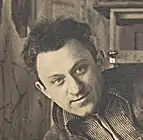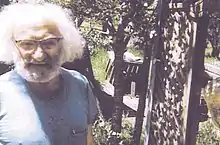Bernard Zakheim
Bernard Baruch Zakheim (April 4, 1898 — 1985) was a Polish-born San Francisco muralist, best known for his work on the Coit Tower murals.
Bernard Zakheim | |
|---|---|
 Zakheim during the painting of the Coit Tower murals, 1934, by Peter Stackpole | |
| Born | April 4, 1898 Poland |
| Died | 1985 California, U.S. |
| Known for | Muralist |
Notable work | "The Library", Coit Tower |
| Website | bernardzakheim.com |
Early life and immigration
Zakheim was born to a Hasidic Jewish family in Poland.[1] At the age of 13, he expressed his desire to become an artist and to work with his hands, rather than to continue his religious training as a rabbi.[2] His mother objected and as a compromise Zakheim was sent to a technical training school to become a furniture designer and upholsterer. However, he did not actually give up on his artistic goal; he studied watercolor art privately and then was awarded a scholarship to the Polish National Academy of Fine Art, where he studied drawing, painting, and sculpture.[3][4]
After fighting in World War I, Zakheim and his wife arrived in San Francisco in 1920, where he lived and worked as a furniture maker in the Fillmore District, then a heavily Jewish neighborhood.[5]
Career
In the early 1930s, he committed himself to the preservation and interpretation of Jewish-American life and culture through the making of art. He was one of the organizers of the Yiddish Folkschule on Steiner Street in San Francisco, where he taught children's art classes, and he organized the first "Yiddish art" exhibit in San Francisco.[3]
Around this time, Zakheim was introduced to the muralist Diego Rivera by Lucretia Van Horn. Turning more seriously to mural painting as a form of expression, he traveled to Mexico, studied with Rivera, and met contemporary San Francisco muralist Victor Arnautoff.[6] He also traveled to Paris, returning with a more developed portfolio.[6]
Back in San Francisco, in 1933 Zakheim helped found the San Francisco Artists and Writers Union, a group of activist artists. The Union lobbied the national government to create a federally funded arts program during the Great Depression. This program became the Public Works of Art Project, and funded Zakheim's work on Coit Tower.
Zakheim's siblings in Poland died as a result of the Nazi Holocaust, and this subject matter became a major focus of his post-war artistic output.[7]
Personal life
In later life, Zakheim moved out of the city to the rural-agricultural town of Sebastopol, California, where he lived on an old apple orchard and continued his work as a painter.
Zakheim had a daughter, Masha Zakheim (1932–2014), who became an art historian and published author, specializing in San Francisco murals and works by Diego Rivera.[8] His daughter Ruth Gottstein (born 1922) was portrayed in her father's mural at Coit Tower, and was an activist for the restoration of the Coit murals.[9][10]
Zakheim's son, Nathan Zakheim, has been an expert in mural restoration for most of his career. He was responsible for restoring many important murals, including a WPA-era mural at San Diego State University,[11] one of Edward Biberman’s iconic murals,[12] some of his own father's work,[13] and the work of his father's contemporary artist and activist Victor Arnautoff.[14]
Works
.jpg.webp)
Contemporaries described Zakheim's style as "bold, clean, and honest".[4] He was considered one of the leading San Francisco muralists of the 1930s, alongside Victor Arnautoff.[6]:95
Coit Tower murals
Zakheim conceptualized the Coit Tower murals, and as part of that project painted the mural "Library", portraying men reading newspapers and books.[6]:143–144 The work reflects Zakheim's own political orientation, as a then-member of the Communist party.[15] For example, fellow artist John Langley Howard reaches for a copy of Das Kapital. It also reflected specific news events happening at the time — one of the newspaper headlines says "Local Artists Protest Destruction of Rivera's Fresco", referring to the destruction of Diego Rivera's "Man at the Crossroads" the year before. Because of this, the mural caused local controversy, with the San Francisco Examiner publishing a photo of the mural under a hammer and sickle (which was not part of Zakheim's design), leading to a temporary stoppage of work and locking of the building before the murals were eventually allowed to be seen by the public.[16]
The History of Medicine in California
Over four years in the 1930s, Zakheim painted ten frescoes in Toland Hall Auditorium on the Parnassus campus of the University of California, San Francisco, titled "The History of Medicine in California".[17][18][19] These received national attention, including a mention in Time magazine.[20] Considered controversial, they were papered over in 1948, and later restored by Zakheim's son Nathan.[18][21][22] One of the murals shows Black nurse Biddy Mason working with John Strother Griffin.[23][24]
UCSF plans to demolish the building; funding is to be sought for moving the murals.[19][23] As an indication of its support for their preservation, the San Francisco Board of Supervisors has begun the process of having them declared a city landmark.[25]

Other murals
In this period he also painted a mural (titled "The Jewish Wedding" or "The Wedding Ceremony") at the San Francisco Jewish Community Center.[3]
Another set of murals were painted at the Alemany Hospital in San Francisco's Outer Mission, built in 1933.[26]
Sculpture
In 1966, Zakheim created six wooden sculptures for one of the first Holocaust memorials in the United States, now displayed at Mount Sinai Memorial Park Cemetery in Los Angeles.[5][27]
Politics and art
Later in life, Zakheim was allegedly rejected for some commissions in part because of his left-leaning politics.[28] However, rather than abandon the political subtexts that informed his art, he advocated that artists should openly espouse their social and religious beliefs within their works. For example, he was a friend of the science fiction author Frank Herbert, and, according to Herbert's biography, he influenced Herbert's work by encouraging him to include political and religious messages in his books.[29]
Restoration and exhibitions
A number of Zakheim's works have been restored since his death, including the UCSF and JCC murals referenced above, as well as two Depression-era works in Texas.[30][31] Two posthumous exhibitions of his work have also been held, in 2009 in Los Angeles[32] and in 2010 in San Francisco.[5]
References
- Schechter, Joel. "Bernard Zakheim's Murals for Justice". The Forward. Retrieved 2020-07-17.
- Boone, Mary Elizabeth (2002). "'Something of his Own Soil': Jewish History, Mural Painting, and Bernard Zakheim in San Francisco". American Jewish History. 90 (2): 123–140. doi:10.1353/ajh.2003.0022. S2CID 154639817. Retrieved 5 June 2013.
- "Permanent Installations: The Jewish Wedding". Jewish Community Center of San Francisco. Retrieved 15 May 2014.
- Hailey, Gene (1936). California Art Research: Maxine Albro, Chin Chee, Bernard Zakheim, Andree Rexroth, Chiura Obata. San Francisco: California Art Research Project. pp. 32–112.
- "Zakheim: The Art of Prophetic Justice at Jazz Heritage Center". Lehrhaus Judaica. Archived from the original on 17 May 2014. Retrieved 5 June 2013.
- Lee, Anthony W. (1999-04-15). Painting on the Left: Diego Rivera, Radical Politics, and San Francisco's Public Murals. University of California Press. ISBN 9780520219779.
- Shaw, Randy. "San Francisco Activist, Artist Bernard Zakheim in Culturally Vital Show at Jazz Heritage Center". Beyond Chron. Retrieved 6 June 2013.
- Nolte, Carl (February 15, 2014). "Masha Zakheim, Coit Tower and Diego Rivera mural expert, dies". SFGate. SFGate. Retrieved September 26, 2014.
- "Depression Art in Jeopardy?". KQED Arts. Retrieved 2017-03-14.
- "Series: Amazing Alumni! - Ruth Gottstein - Camp Tawonga". Camp Tawonga. 2015-05-14. Retrieved 2017-03-14.
- Petrillo, Lisa (June 19, 2006). "Can recently discovered murals at SDSU be restored? And at what cost?". UT San Diego. Archived from the original on August 13, 2016. Retrieved June 22, 2016.
- Kaufman, Claire (July 9, 2014). "A mural on the move". Argonaut Online.
- Pine, Dan (October 14, 2010). "Tribute to a muralist: Exhibit to reveal the genius of late Bay Area artist Bernard Zakheim". JWeekly.com.
- "Lost Mural by Secret Communist Unearthed in Richmond Basement". KQED Arts. Retrieved 2017-11-05.
- Rosenbaum, Fred (2009). Cosmopolitans: A Social and Cultural History of the Jews of the San Francisco Bay Area. UC Press. p. 277. ISBN 9780520945029.
- Jewett, Masha Zakheim. "Coit Tower Politics". Found SF. Retrieved 2013-06-06.
- "Bernard Zakheim". UCSF Art Collection on Parnassus Campus. University of California-San Francisco. Archived from the original on 2014-05-18. Retrieved 2013-06-05.
- Nolte, Carl (2015-02-28). "UCSF to let public see trove of medical history murals". San Francisco Chronicle.
- Dineen, J. K. (2020-06-12). "UCSF New Deal murals could be destroyed". San Francisco Chronicle.
- "Art: Government Inspiration". Time Magazine. 1936-03-02. Retrieved 2013-06-06.
- MacGowan, Gail. "San Francisco Mural Month of May". Guidelines. Retrieved 2013-06-05.
- "Recent Acquisition: Bernard Zakheim Collection". Brought to Light: Stories from UCSF Archives & Special Collections. 2015-02-24. Retrieved 2017-03-14.
- Broxton, Jackie; Waite, Kevin (2020-07-10). "A monument to California's Black history may soon be destroyed". Los Angeles Times (opinion). Retrieved 2020-07-17.
- Pogash, Carol (2020-08-11). "A Black Nurse Saved Lives. Today She May Save Art". The New York Times. ISSN 0362-4331. Retrieved 2020-08-13.
- Dineen, J. K. (2020-07-22). "SF supervisors take an interest in preserving WPA murals at UCSF Parnassus campus". San Francisco Chronicle.
- Chavez, Nashelly (2016-03-20). "Community hopes to revive former hospital for public use". The San Francisco Examiner. Retrieved 2017-03-14.
- "Memorial to the Six Million - Mt. Sinai Memorial Park - Los Angeles, CA". Waymarking.com. 2009-10-19. Retrieved 2014-07-21.
- Schechter, Joel. "Bernard Zakheim's Murals for Justice". The Arty Semite. Retrieved 2013-06-06.
- Herbert, Brian (2003). Dreamer of Dune: the Biography of Frank Herbert. Macmillan. pp. 258. ISBN 9780765306463.
Bernard Zakheim, my father's artist friend, invariably included anti-holocaust political messages and religious quotations with his paintings and sculptures. Similarly, Dad wanted his own important messages to be contained within every novel he wrote...
- Associated Press (Feb 19, 2011). "Texas artist's son works to restore historic mural". KHOU. Archived from the original on 17 May 2014. Retrieved 6 June 2013.
- Randall, Lindsay. "Mineola Post Office Museum Unveils Historic Mural" (PDF). Tyler Morning Telegraph. Retrieved 6 June 2013.
- Vallen, Mark. "The Art of Bernard Zakheim". Art For a Change. Retrieved 6 June 2013.
Further reading
- Portrait of Zakheim at work on the Coit Murals, by Peter Stackpole
- Official website; includes many photos of art and artist
- Bernard Zakheim's Art, by Margot Smith on YouTube
- Zakheim: The Art of Prophetic Justice, from "This Week in Northern California" on KQED
- Bernard Zakheim archival collection at UCSF
- "Bernard Zakheim, Polish American Artist of California" by Robert Sherins; contains extensive detail on family history and many images of the artist's work.